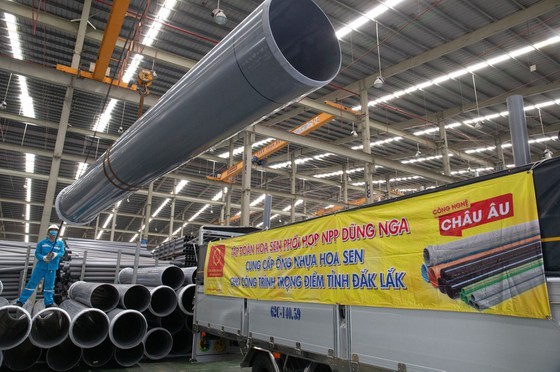 Hoa Sen plastic pipe factory provides products to main works in the country.
Hoa Sen plastic pipe factory provides products to main works in the country.
The “localization of raw material supply” strategy with short-term and long-term solutions is expected to help enterprises actively seek the input.
From the beginning of 2021 to the present, the country’s plastic industry has imported 5.33 million tons of plastic materials worth US$8.86 million, up 9.2 percent in volume and 47.9 percent in value over the same period in 2020.
General Director of Binh Minh Plastics Joint Stock Company Nguyen Hoang Ngan said that around 80 percent of raw plastic materials for manufacturing activities in Vietnam has been imported from China, Thailand, South Korea and Middle Eastern countries.
The import turnover of raw materials and accessories for the textile, garment, leather, and footwear sector was US$19.6 billion, presenting a year-on-year increase of 26.9 percent. China is still the country's main importer of raw materials.
The complicated development of the Covid-19 global epidemic has caused a disruption on production activities of factories around the world and put shipping companies in danger of bankruptcy as well as led to a shortage of raw materials. The price of raw materials has increased from 20-300 percent compared to the 2019. Besides, expenditure on prevention and control activities and production suspension mid the pandemic are causes of a decrease of businesses’ turnover, he added.
Chairperson of directors of the Saigon 3 Garment Joint-Stock Company Pham Xuan Hong noted that the China’s raw-material producing industry now focuses on the recovery of domestic enterprises. Additionally, China’s development trend is not to prioritize the development of industries that cause environmental degradation, making it hard for Vietnamese businesses to find sources of raw materials.
Chairman of the Viet Nam Textile & Apparel Association (VITAS) Vu Duc Giang said that Vietnam has many companies manufacturing raw materials that key export industries in the country need. Yet, domestic enterprises must import raw materials at higher prices due to costs of transport, tariff, and tests for purity, identity, and quality.
The functional units must also offer priority to raw materials investors and launch conditions of the supply ratio to the domestic market to foreign direct investments (FDI) businesses to avoid the surplus of production of domestic raw materials but local enterprises depend on raw materials imported from abroad
The Government needs to boost the building “localization of raw material supply” strategy, select enterprises producing raw materials with a stable export turnover of US$200 million per year and support them to expand production and supply of raw materials
























